Make a summary of Magala In Search of Its Identity as a Smart City and provide a short description !
DIESE ICC Business School University of Navarra Mlaga: In Search of Its Identity as a Smart City sod IES671 December 2017 "He can who thinks he can, and he can't who thinks he can't. This is an inexorable, indisputable law." "All that can be imagined is real." Pablo Ruiz Picasso Introduction In July 2017, Francisco de la Torre, the mayor of Mlaga for the last 17 years, was still thinking about how he could persuade decision-makers at the European Medicines Agency (EMA) that they should base their headquarters in the city. After the United Kingdom's decision to leave the European Union, the Agency was planning to relocate from London to another EU member state. Several cities, including Barcelona, were vying to host the EMA. Although Barcelona appeared to have the best chance of success-it had a powerful pharmaceutical industry and was a hub for scientific research-De la Torre continued to seek support at the regional and national level so that Mlaga would also be considered. In addition to the technical and scientific capabilities the city offered, it would need to provide suitable premises for the headquarters. The 74-year-old mayor had been involved in politics for a long time. He was passionate about his city and proud of the change it had undergone in recent years. Mlaga was a pre-eminent tourist destination, but following the introduction of a strategic plan in 1996, it had built a narrative around the idea that it was a city of culture and innovation. This approach had borne fruit, and the city had received various awards in recognition of its achievements. In a public appearance on July 7, 2017, De la Torre drew attention to the recently published IESE Cities in Motion Index, prepared by the IESE Center for Globalization and Strategy, which ranked Mlaga second among Spanish cities in the dimension of international outreach (behind Barcelona and ahead of Madrid). Globally, the city was ranked 13th in this dimension..2

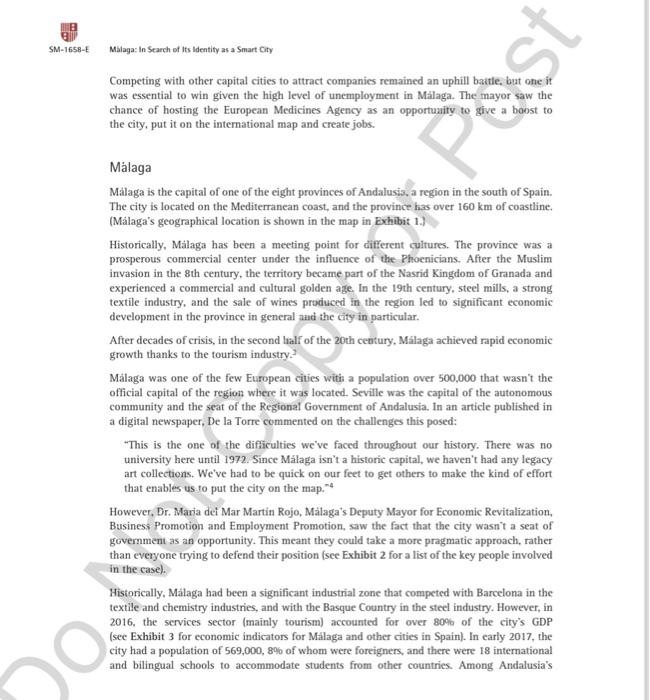
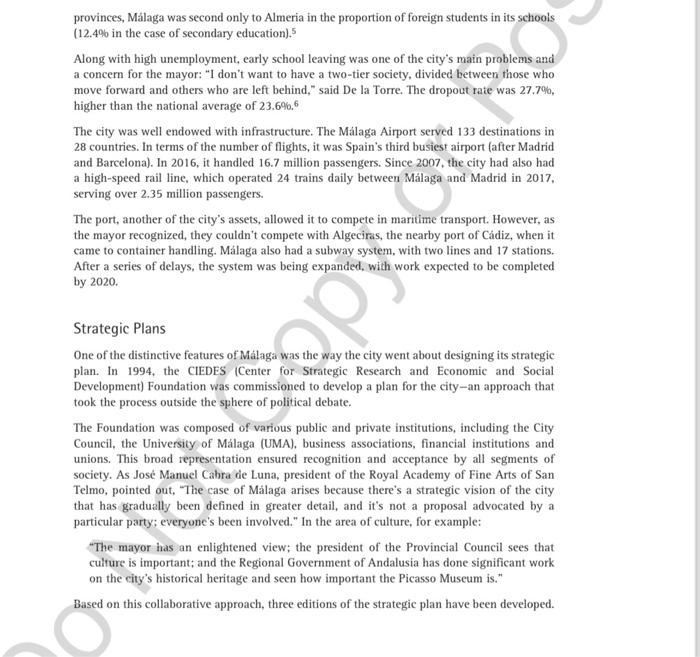
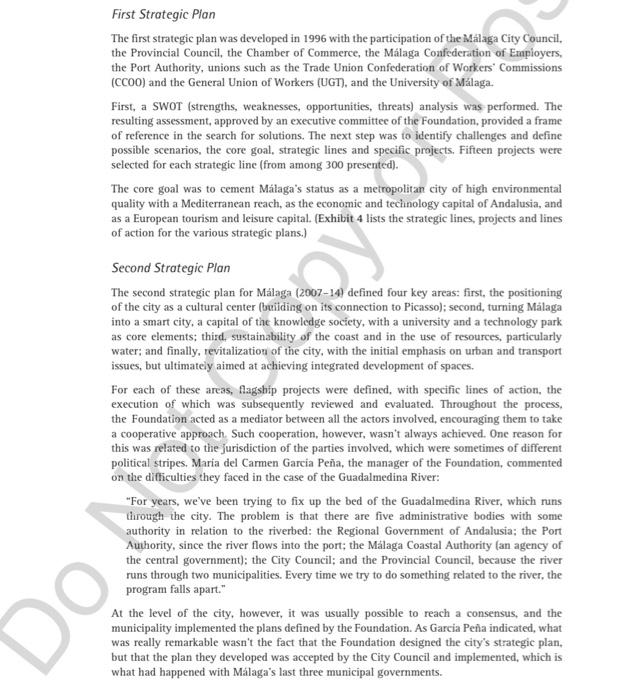
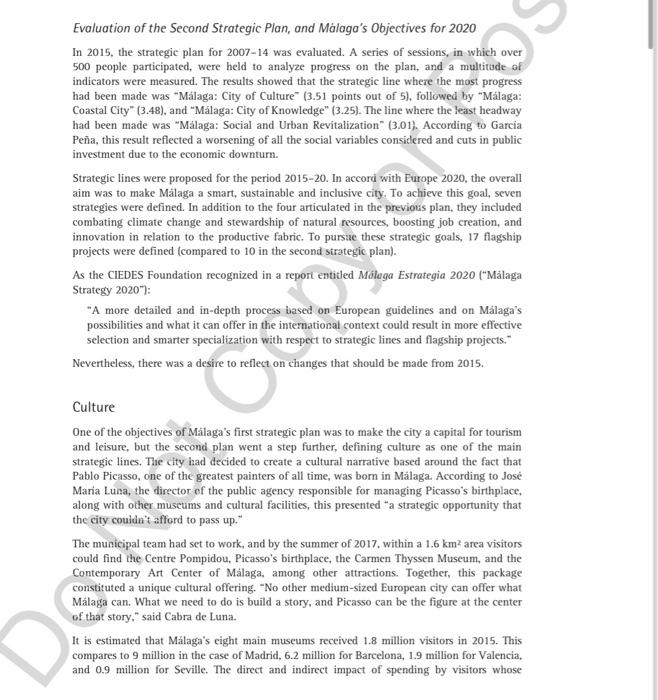

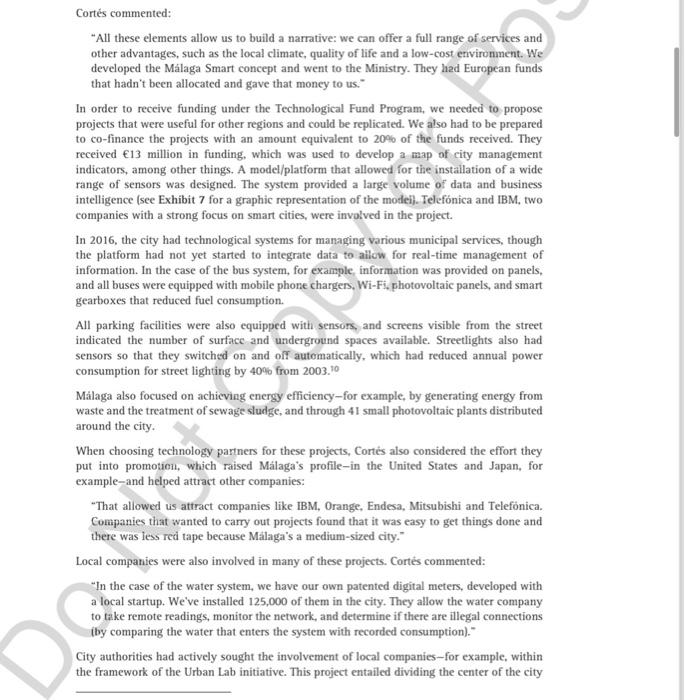
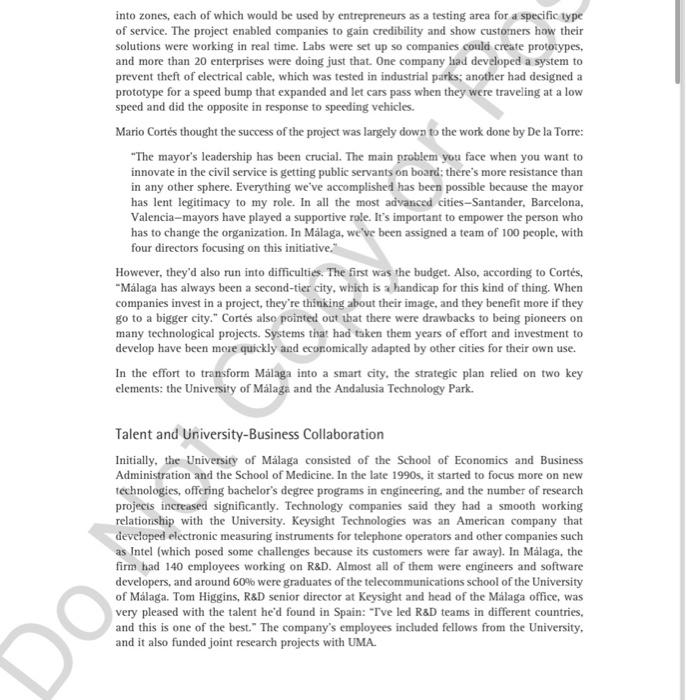

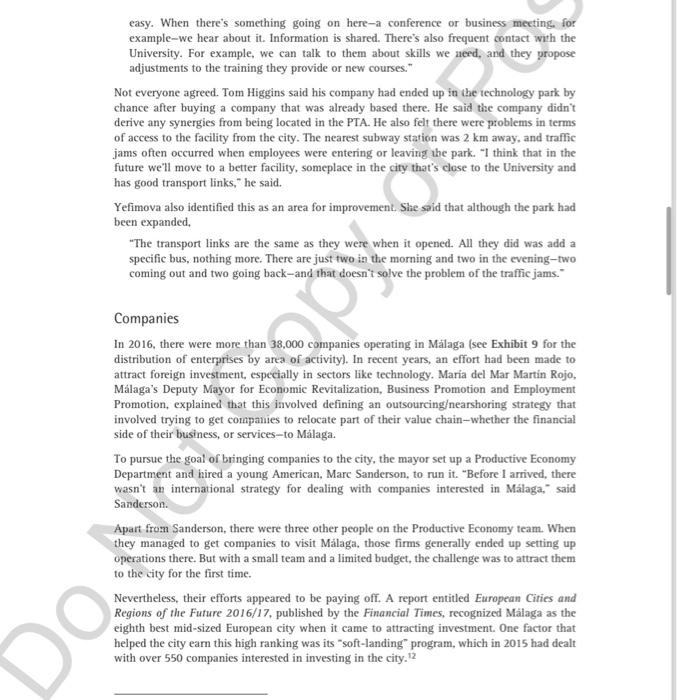
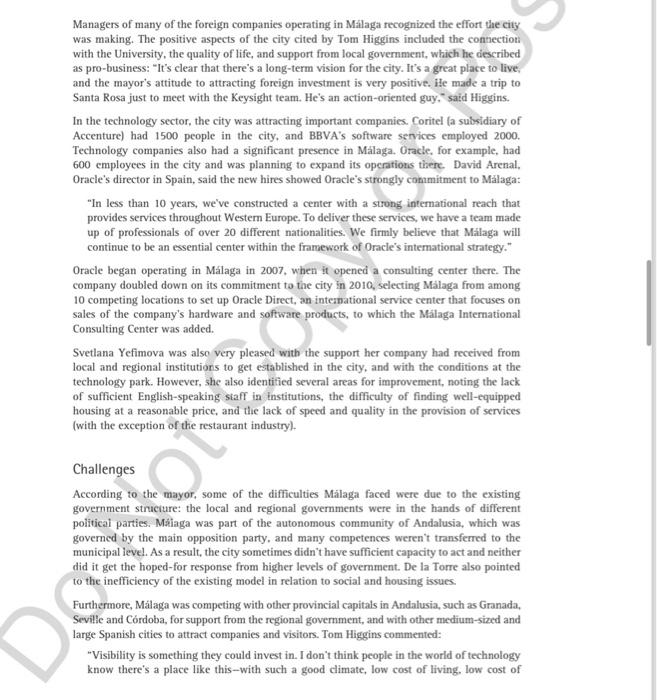

Mlaga: In Search of Its Identity as a Smart City "He can who thinks he can, and he can't who thinks he can't. This is an inerorable, indisputable law." "All that can be imagined is real." Pablo Ruiz Picasso Introduction In July 2017, Francisco de la Torre, the mayor of Malaga for the last 17 years, was still thinking about how he could persuade decision-makers at the European Medicines Agency (EMA) that they should base their headquarters in the eity. After the United Kingdom's decision to leave the European Union, the Agency was planning to relocate from London to another EU member state. Several cities, including Barcelona, were vying to host the EMA. Although Barcelona appeared to have the best chance of success-it had a powerful pharmaceutical industry and was a hub for scientific research-De la Torre continued to seek support at the regional and national level so that Malaga would also be considered. In addition to the technical and scientific capabilities the city offered, it would need to provide suitable premises for the headquarters. The 74-year-old mayor had been involved in politics for a long time. He was passionate about his city and proud of the change it had undergone in recent years. Malaga was a pre-eminent tourist destination, but following the introduction of a strategic plan in 1996, it had built a narrative around the idea that it was a city of culture and innovation. This approach had borne fruit, and the city had received various awards in recognition of its achievements. In a public appearance on July 7, 2017, De la Torre drew attention to the recently published IESE Cities in Motion Index, prepared by the IESE Center for Globalization and Strategy, which ranked Mlaga second among Spanish cities in the dimension of international outreach (behind Barcelona and ahead of Madrid). Globally, the city was ranked 13 th in this dimension. 1,2 Malaga: In Search of Its identity as a Smart City Competing with other capital cities to attract companies remained an uphill batte, but one it was essential to win given the high level of unemployment in Malaga. The mayor saw the chance of hosting the European Medicines Agency as an opportuaity to give a boost to the city, put it on the international map and create jobs. Mlaga Malaga is the capital of one of the eight provinces of Andalusis, a region in the south of Spain. The city is located on the Mediterranean coast, and the province has over 160km of coastline. (Mlaga's geographical location is shown in the map in Exhibit 1.) Historically, Malaga has been a meeting point for different cultures. The province was a prosperous commercial center under the influence of the Phoenicians. After the Muslim invasion in the 8th century, the territory became part of the Nasrid Kingdom of Granada and experienced a commercial and cultural golden age. In the 19th century, steel mills, a strong textile industry, and the sale of wines produced in the region led to significant economic development in the province in general aad the city in particular. After decades of crisis, in the second thalf of the 20 th century, Malaga achieved rapid economic growth thanks to the tourism industry.? Malaga was one of the few European cities witi a population over 500,000 that wasn't the official capital of the region where it was located. Seville was the capital of the autonomous community and the seat of the Regional Government of Andalusia. In an article published in a digital newspaper, De la Torre commented on the challenges this posed: "This is the one of the difficulties we've faced throughout our history. There was no university here until 1972. Since Mallaga isn't a historic capital, we haven't had any legacy art collections. We've had to be quick on our feet to get others to make the kind of effort that enables us to put the city on the map. 4 However, Dr. Maria dei Mar Martin Rojo, Malaga's Deputy Mayor for Economic Revitalization, Business Promotion and Employment Promotion, saw the fact that the city wasn't a seat of government as an opportunity. This meant they could take a more pragmatic approach, rather than everyone trying to defend their position (see Exhibit 2 for a list of the key people involved in the case). Histonically, Malaga had been a significant industrial zone that competed with Barcelona in the textile and chemistry industries, and with the Basque Country in the steel industry. However, in 2016, the services sector (mainly tourism) accounted for over 80% of the city's GDP (see Exhibit 3 for economic indicators for Malaga and other cities in Spain). In early 2017, the city had a population of 569,000,8% of whom were foreigners, and there were 18 international and bilingual schools to accommodate students from other countries. Among Andalusia's provinces, Malaga was second only to Almeria in the proportion of foreign students in its schools (12.4% in the case of secondary education)..5 Along with high unemployment, early school leaving was one of the city's main problems and a concern for the mayor: "I don't want to have a two-tier society, divided between those who move forward and others who are left behind," said De la Torre. The dropout rate was 27.7\%, higher than the national average of 23.6%.6 The city was well endowed with infrastructure. The Malaga Airport served 133 destinations in 28 countries. In terms of the number of flights, it was Spain's third busiest airport (after Madrid and Barcelona). In 2016, it handled 16.7 million passengers. Since 2007, the city had also had a high-speed rail line, which operated 24 trains daily between Mlaga and Madrid in 2017. serving over 2.35 million passengers. The port, another of the city's assets, allowed it to compete in maritime transport. However, as the mayor recognized, they couldn't compete with Algecirss, the nearby port of Cadiz, when it came to container handling. Mlaga also had a subway system, with two lines and 17 stations. After a series of delays, the system was being expanded, with work expected to be completed by 2020. Strategic Plans One of the distinctive features of Mallaga was the way the city went about designing its strategic plan. In 1994, the CIEDES (Center for Strategic Research and Economic and Social Development) Foundation was commissioned to develop a plan for the city-an approach that took the process outside the sphere of political debate. The Foundation was composed of various public and private institutions, including the City Council, the University of Mlaga (UMA), business associations, financial institutions and unions. This broad representation ensured recognition and acceptance by all segments of society. As Jos Manuel Cabra de Luna, president of the Royal Academy of Fine Arts of San Telmo, pointed out, "The case of Malaga arises because there's a strategic vision of the city that has gradually been defined in greater detail, and it's not a proposal advocated by a particular party; everyone's been involved." In the area of culture, for example: "The mayor has an enlightened view; the president of the Provincial Council sees that culture is important; and the Regional Government of Andalusia has done significant work on the city's historical heritage and seen how important the Picasso Museum is." Based on this collaborative approach, three editions of the strategic plan have been developed. First Strategic Plan The first strategic plan was developed in 1996 with the participation of the Malaga City Council. the Provincial Council, the Chamber of Commerce, the Malaga Coufederation of Eapioyers, the Port Authority, unions such as the Trade Union Confederation of Workers' Commissions (CCOO) and the General Union of Workers (UGT), and the University of Malaga. First, a SWOT (strengths, weaknesses, opportunities, threats) analysis was performed. The resulting assessment, approved by an executive committee of the Foundation, provided a frame of reference in the search for solutions. The next step was to identify challenges and define possible scenarios, the core goal, strategic lines and specific projects. Fifteen projects were selected for each strategic line (from among 300 presented). The core goal was to cement Mlaga's status as a metropolitan city of high environmental quality with a Mediterranean reach, as the economic and teclinology capital of Andalusia, and as a European tourism and leisure capital. (Exhibit 4 lists the strategic lines, projects and lines of action for the various strategic plans.) Second Strategic Plan The second strategic plan for Malaga (2007-14) defined four key areas: first, the positioning of the city as a cultural center (building on its connection to Picasso): second, turning Malaga into a smart city, a capital of the knowledge society, with a university and a technology park as core elements; third, sustainability of the coast and in the use of resources, particularly water; and finally, revitalization of the city, with the initial emphasis on urban and transport issues, but ultimateiy aimed at achieving integrated development of spaces. For each of these areas, flagship projects were defined, with specific lines of action, the execution of which was subsequently reviewed and evaluated. Throughout the process, the Foundation acted as a mediator between all the actors involved, encouraging them to take a cooperative approsch. Such cooperation, however, wasn't always achieved. One reason for this was related to the Jurisdiction of the parties involved, which were sometimes of different political stripes. Maria del Carmen Garcia Pea, the manager of the Foundation, commented on the difficulties they faced in the case of the Guadalmedina River: "For years, we've been trying to fix up the bed of the Guadalmedina River, which runs through the city. The problem is that there are five administrative bodies with some authority in relation to the riverbed: the Regional Government of Andalusia; the Port Auhority, since the river flows into the port; the Malaga Coastal Authority (an agency of the central government): the City Council; and the Provincial Council, because the river runs through two municipalities. Every time we try to do something related to the river, the program falls apart." At the level of the city, however, it was usually possible to reach a consensus, and the municipality implemented the plans defined by the Foundation. As Garcia Pea indicated, what was really remarkable wasn't the fact that the Foundation designed the city's strategic plan, but that the plan they developed was accepted by the City Council and implemented, which is what had happened with Mlaga's last three municipal governments. Evaluation of the Second Strategic Plan, and Mlaga's Objectives for 2020 In 2015, the strategic plan for 2007-14 was evaluated. A series of sessions, in which over 500 people participated, were held to analyze progress on the plan, and a multitude of indicators were measured. The results showed that the strategic line where the most progress had been made was "Mlaga: City of Culture" ( 3.51 points out of 5 ), followed by "Mlaga: Coastal City" (3.48), and "Malaga: City of Knowledge" (3.25). The line where the least headway had been made was "Mlaga: Social and Urban Revitalization" (3.01). According to Garcia Pea, this result reflected a worsening of all the social variables considered and cuts in public investment due to the economic downturn. Strategic lines were proposed for the period 2015-20. In accord with Europe 2020, the overall aim was to make Mlaga a smart, sustainable and inclusive city. To achieve this goal, seven strategies were defined. In addition to the four articulated in the previous plan, they included combating climate change and stewardship of natural resources, boosting job creation, and innovation in relation to the productive fabric. To pursae these strategic goals, 17 flagship projects were defined (compared to 10 in the second strategic plan). As the CIEDES Foundation recognized in a report entitled Mallaga Estrategia 2020 ("Mlaga Strategy 20207): "A more detailed and in-depth process based on European guidelines and on Malaga's possibilities and what it can offer in the international context could result in more effective selection and smarter specialization with respect to strategic lines and flagship projects." Nevertheless, there was a desire to reflect on changes that should be made from 2015. Culture One of the objectives of Malaga's first strategic plan was to make the city a capital for tourism and leisure, but the second plan went a step further, defining culture as one of the main strategic lines. The city had decided to create a cultural narrative based around the fact that Pablo Picasso, one of the greatest painters of all time, was born in Mlaga. According to Jos Maria Luna, the director of the public agency responsible for managing Picasso's birthplace, along with other muscums and cultural facilities, this presented "a strategic opportunity that the city couidin't afford to pass up." The municipal team had set to work, and by the summer of 2017 , within a 1.6km2 area visitors could find the Centre Pompidou, Picasso's birthplace, the Carmen Thyssen Museum, and the Contemporary Art Center of Malaga, among other attractions. Together, this package constituted a unique cultural offering. "No other medium-sized European city can offer what Mlaga can. What we need to do is build a story, and Picasso can be the figure at the center of that story," said Cabra de Luna. It is estimated that Mlaga's eight main museums received 1.8 million visitors in 2015. This compares to 9 million in the case of Madrid, 6.2 million for Barcelona, 1.9 million for Valencia, and 0.9 million for Seville. The direct and indirect impact of spending by visitors whose motivation is to visit museums was estimated at almost 547 million 7 (see Exhibit 5 for average daily expenditure per tourist). One factor that had made this possible was the consensus that underpinned the strategie plan. However, several of the actors involved recognized that the mayor's personal involvement had also played a key role. In fact, it was at a soccer match between the Spanish national team and the French team at the Rosaleda Stadium (played in Mlaga on February 7, 2008) that De la Torre told the French ambassador, Bruno Delaye, that the city had set itself the goal of hosting a branch of the Louvre or the Centre Pompidou. The deal to bring the Centre Pompidou to Mlaga was closed five years later. Mlaga: Smart City Transforming Mlaga into a smart city was another objective under the 2007-11 strategic plan. In 2007, the electrical utility company Endesa had developed the first smart grid structure, which facilitated the development of an electric vehicle network. The Japanese government invested 60 million, and companies such as Endesa and Telefnica also participated in the project. A corridor of charging stations and 200 vehicles were deployed. 8 The project was completed in December 2015 and received several electric mobility awards. In 2011, the mayor of Mallaga put Mario Corts-Deputy Mayor, Spokesman and Officer for Innovation, New Technologies and Security of the Malaga City Council-in charge of information technology, new technologies and security in the city. Corts quickly realized good progress was being made in various areas and built on this momentum: -This was right at the time of the smart city boom, and we put the city forward for consideration. We realized that several departments had been doing things for years. We put it all together and Mlaga was recognized as the smartest city in Spain. 9 It was the first public recognition of what Malaga had achieved in the field of technology." In the following years, the city received various recognitions in the areas of science, innovation and energy efficiency (see Exhibit 6). The projects underway when Corts assumed responsibility for these areas included Malaga Valley, an initiative that emerged from the business community and was aimed at transforming the city inte a European equivalent of Silicon Valley. Corts sought to give the project territorial impetus by developing the Mlaga Valley strategy, a technology and entrepreneurial ecosystem with various pillars: the Mlaga Valley Club, whose members were company presidents; the University of Malaga, which provided engineers; an entrepreneurial ecosystem (consisting of 10 municipal incubators and the technology park); and startup accelerators. Corts commented: "All these elements allow us to build a narrative: we can offer a full range of services and other advantages, such as the local climate, quality of life and a low-cost envirumment. We developed the Mlaga Smart concept and went to the Ministry. They laed European funds that hadn't been allocated and gave that money to us.- In order to receive funding under the Technological Fund Program, we needed to propose projects that were useful for other regions and could be replicated. We also had to be prepared to co-finance the projects with an amount equivalent to 20% of the funds received. They received 13 million in funding, which was used to develop a map of city management indicators, among other things. A model/platform that allowed for the installation of a wide range of sensors was designed. The system provided a large volume of data and business intelligence (see Exhibit 7 for a graphic representation of the modei). Telefnica and IBM, two companies with a strong focus on smart cities, were involved in the project. In 2016, the city had technological systems for managing various municipal services, though the platform had not yet started to integrate data to allow for real-time management of information. In the case of the bus system, for example, information was provided on panels, and all buses were equipped with mobile phone chargers, Wi-Fi, photovoltaic panels, and smart gearboxes that reduced fuel consumption. All parking facilities were also equipped with sensors, and screens visible from the street indicated the number of surface and underground spaces available. Streetlights also had sensors so that they switched on and off automatically, which had reduced annual power consumption for street lighting by 40% from 2003.10 Mlaga also focused on achicving energy efficiency-for example, by generating energy from waste and the treatment of sewage sludge, and through 41 small photovoltaic plants distributed around the city. When choosing technology partners for these projects, Corts also considered the effort they put into promotion, which raised Malaga's profile-in the United States and Japan, for example-and helped attract other companies: "That allowed us attract companies like IBM, Orange, Endesa, Mitsubishi and Telefnica. Companies that wanted to carry out projects found that it was easy to get things done and there was less red tape because Mallaga's a medium-sized city." Local companies were also involved in many of these projects. Corts commented: In the case of the water system, we have our own patented digital meters, developed with a local startup. We've installed 125,000 of them in the city. They allow the water company to take remote readings, monitor the network, and determine if there are illegal connections (by comparing the water that enters the system with recorded consumption)." City authorities had actively sought the involvement of local companies-for example, within the framework of the Urban Lab initiative. This project entailed dividing the center of the city into zones, each of which would be used by entrepreneurs as a testing area for a specific type of service. The project enabled companies to gain credibility and show customers how their solutions were working in real time. Labs were set up so companies could create prototypes, and more than 20 enterprises were doing just that. One company had developed a system to prevent theft of electrical cable, which was tested in industrial parks; another had designed a prototype for a speed bump that expanded and let cars pass when they were traveling at a low speed and did the opposite in response to speeding vehicles. Mario Cortes thought the success of the project was largely down to the work done by De la Torre: "The mayor's leadership has been crucial. The main problem you face when you want to innovate in the civil service is getting public servants on board: there's more resistance than in any other sphere. Everything we've accomplished has been possible because the mayor has lent legitimacy to my role. In all the most advanced cities-Santander, Barcelona, Valencia-mayors have played a supportive role. It's important to empower the person who has to change the organization. In Malaga, we've been assigned a team of 100 people, with four directors focusing on this initiative. However, they'd also run into difficulties. The first was the budget. Also, according to Corts, -Mallaga has always been a second-tier city, which is a handicap for this kind of thing. When companies invest in a project, they're thiniking about their image, and they benefit more if they go to a bigger city." Corts also pointed out that there were drawbacks to being pioneers on many technological projects. Systems that had taken them years of effort and investment to develop have been more quickly and economically adapted by other cities for their own use. In the effort to transform Malaga into a smart city, the strategic plan relied on two key elements: the University of Malaga and the Andalusia Technology Park. Talent and University-Business Collaboration Initially, the University of Malaga consisted of the School of Economics and Business Administration and the School of Medicine. In the late 1990s, it started to focus more on new technologies, offering bachelor's degree programs in engincering, and the number of research projecis increased significantly. Technology companies said they had a smooth working relationship with the University. Keysight Technologies was an American company that developed electronic measuring instruments for telephone operators and other companies such as Intel (which posed some challenges because its customers were far away). In Malaga, the firm had 140 employees working on R\&D. Almost all of them were engineers and software developers, and around 60% were graduates of the telecommunications school of the University of Malaga. Tom Higgins, R\&D senior director at Keysight and head of the Malaga office, was very pleased with the talent he'd found in Spain: "Tve led RsD teams in different countries, and this is one of the best." The company's employees included fellows from the University. and it also funded joint research projects with UMA. Svetlana Yefimova, the Spanish branch manager of Ciklum, a Kiev-based software development company with operations in Malaga, also recognized the benefits of this interaction: -We're in frequent contact with the University. For example, we can talk to then about skills we need, and they propose adjustments to the training they provide or new courses. In 2016, they launched a master's degree in Big Data with cooperation and funding from several companies." Yefimova had brought 20% of its 70 employees from Ukraine and hired the rest in Mallaga and other Spanish cities. "Universities are much better equipped here than they are in Ukraine. People are smart, but they're three years behind Ukraine and Poland when it comes to new technologies," she said. In 2017, there were more than 35,000 students enrolled in the University, in 58 bachelor's degrees and 53 master's programs. The University was a core elenent of the strategic area of innovation, and there was a push to boost technology-oriented programs, but legal studies and social science programs continued to attract more students. (Over 20,000 students were enrolled in legal studies and social science programs versus 7500 in technical programs; see Exhibit 8 for information on graduates). 11 According to Mare Sanderson, the Malaga City Council director responsible for attracting international investment, one key factor in relation to talent in Malaga was the strong attachment local people had to their city. Sanderson was surprised how reluctant locals were to study or work abroad: This hurts companies when there's an economic downturn, because they don't have contacts to sell their products abroad. It also hurts the city because there are no people from Mlaga in senior management positions at multinationals-no one who can exert an influence so certain investunents are made here. There aren't enough ambassadors for the city. The people of Malaga sometimes prefer not to be promoted if it means moving away. because they value the quality of life in Malaga." Andalusia Technology Park In 1988, the Regional Government of Andalusia and the Malaga City Council agreed to set up a technology park that would open in 1992. The Andalusia Technology Park (PTA), located on the outskirts of the city, was home to 600 companies and provided employment to almost 17,000 people. About 70 foreign-owned firms, with an annual tumover of around 1.5 billion, had facilities in the technology park, which was also used as a venue for conferences, exhibitions and business meetings. Svetlana Yefimova, the manager of Ciklum, one of the companies that operated in the PTA, was very satisfied with the facility: -On my first visit to Malaga, they showed us seven or eight options that were available in the technology park. Our technological infrastructure requirements were met. It was very easy. When there's something going on here-a conference or business meeting for example-we hear about it. Information is shared. There's also frequent contact with the University. For example, we can talk to them about skills we need, and they propose adjustments to the training they provide or new courses." Not everyone agreed. Tom Higgins said his company had ended up in the iechnology park by chance after buying a company that was already based there. He said the company didn't derive any synergies from being located in the PTA. He also felt there were problems in terms of access to the facility from the city. The nearest subway station was 2km away, and traffic jams often occurred when employees were entering or leaving the park. 1 think that in the future we'll move to a better facility, someplace in the city that's close to the University and has good transport links, " he said. Yefimova also identified this as an area for improvement. She soid that although the park had been expanded, "The transport links are the same as they were when it opened. All they did was add a specific bus, nothing more. There are just two in the morning and two in the evening-two coming out and two going back-and that doesn't solve the problem of the traffic jams.- Companies In 2016, there were more than 38,000 companies operating in Malaga (see Exhibit 9 for the distribution of enterprises by area of activity). In recent years, an effort had been made to attract foreign investment, especially in sectors like technology. Maria del Mar Martin Rojo, Mlaga's Deputy Mayor for Economic Revitalization, Business Promotion and Employment Promotion, explained that this involved defining an outsourcingearshoring strategy that involved trying to get companies to relocate part of their value chain-whether the financial side of their business, or services-to Mallaga. To pursue the goal of bringing companies to the city, the mayor set up a Productive Economy Department and hired a young American, Marc Sanderson, to run it. "Before 1 arrived, there wasn't an international strategy for dealing with companies interested in Malaga," said Sanderson. Apart from Sanderson, there were three other people on the Productive Economy team. When they managed to get companies to visit Malaga, those firms generally ended up setting up operations there. But with a small team and a limited budget, the challenge was to attract them to the city for the first time. Nevertheless, their efforts appeared to be paying off. A report entitled European Cities and Regions of the Future 2016/17, published by the Financial Times, recognized Malaga as the eighth best mid-sized European city when it came to attracting investment. One factor that helped the city earn this high ranking was its "soft-landing" program, which in 2015 had dealt with over 550 companies interested in investing in the city. 12 Managers of many of the foreign companies operating in Malaga recognized the effort the city was making. The positive aspects of the city cited by Tom Higgins included the connection with the University, the quality of life, and support from local government, which he described as pro-business: "It's clear that there's a long-term vision for the city. It's a great place to live, and the mayor's attitude to attracting forcign investment is very positive. Ife made a trip to Santa Rosa just to meet with the Keysight team. He's an action-oriented guy," saitd Higgins. In the technology sector, the city was attracting important companies. Coritel (a subsidiary of Accenture) had 1500 people in the city, and BBVA's software services employed 2000. Technology companies also had a significant presence in Malaga. Oracle, for example, had 600 employees in the city and was planning to expand its operations there. David Arenal, Oracle's director in Spain, said the new hires showed Oracle's strongly commitment to Malaga: "In less than 10 years, we've constructed a center with a strong intemational reach that provides services throughout Westem Europe. To deliver these services, we have a team made up of professionals of over 20 different nationalities. We firmly believe that Malaga will continue to be an essential center within the framework of Oracle's intemational strategy." Oracle began operating in Malaga in 2007, when it opened a consulting center there. The company doubled down on its commitment to the city in 2010 , selecting Malaga from among 10 competing locations to set up Oracle Direct, an international service center that focuses on sales of the company's hardware and software products, to which the Malaga Intermational Consulting Center was added. Svetlana Yefimova was also very pleased with the support her company had received from local and regional institutions to get established in the city, and with the conditions at the technology park. However, she also identitied several areas for improvement, noting the lack of sufficient English-speaking staff in institutions, the difficulty of finding well-equipped housing at a reasonable price, and the lack of speed and quality in the provision of services (with the exception of the restaurant industry). Challenges According to the mayor, some of the difficulties Malaga faced were due to the existing government struciure: the local and regional governments were in the hands of different political parties. Matiaga was part of the autonomous community of Andalusia, which was governed by the main opposition party, and many competences weren't transferred to the municipal level. As a result, the city sometimes didn't have sufficient capacity to act and neither did it get the hoped-for response from higher levels of govermment. De la Torre also pointed to the inefficiency of the existing model in relation to social and housing issues. Furthermore, Malaga was competing with other provincial capitals in Andalusia, such as Granada, Seville and Crdoba, for support from the regional government, and with other medium-sized and large Spanish cities to attract companies and visitors. Tom Higgins commented: "Visibility is something they could invest in. I don't think people in the world of technology know there's a place like this-with such a good climate, low cost of living, low cost of talent, high level of professional talent, a good university... It's a very attractive package. Managers who come here go away very impressed." They also needed to define the positioning of the city and decide how to leverage efforts to transform Malaga into a city of knowledge and culture in that context. Was its positioning consistent with initiatives such as attracting the European Medicines Agency to the city? Would strengthening the city's positioning solve the problems it was facing? Although the mayor was pleased with what had been achieved in recent years, he was thinking about everything that remained to be done as he looked ahead to the last two years of his term


















